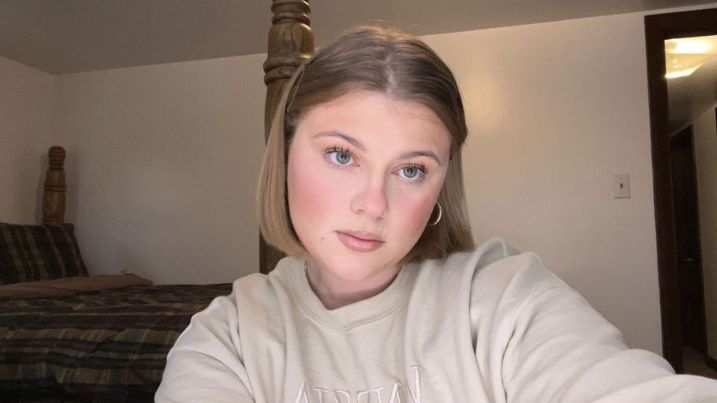Allegheny Health Network’s media relations team is dedicated to providing reporters and other members of the news media with the assistance they need.

AHN neurosurgeon saves young patient from debilitating symptoms of Tourette syndrome using deep brain stimulation
Pittsburgh, PA — For most of her life, 24-year-old Abigail Bailey of Hookstown, Pa., lived in the grip of severe Tourette syndrome. Diagnosed at age 3, her days were consumed by painful motor and vocal tics that eventually led to broken fingers and ribs, constant exhaustion, and years of missed opportunities. By early 2024, her condition — and its associated side effects — had worsened so much that she was bedridden and forced to leave her job.
This year, everything changed.
In March, Abigail underwent deep brain stimulation (DBS) surgery at Allegheny Health Network’s (AHN) Allegheny General Hospital (AGH), performed by Donald Whiting, MD, chair of the AHN Neuroscience Institute and a leading national expert in the use of DBS to treat complex neurologic disorders.
Today, Abigail is working again, planning her wedding, and living with a freedom she thought she’d never know. Post-surgery, her tics have been dramatically reduced — from one every second to just a few an hour — and as the brain-stimulation amplitude continues to be adjusted, the tics should go away completely.
“After my surgery, I feel like I finally have my life back,” Abigail said. “I’m working again, I’ve moved out on my own, and I’m planning my wedding. These are all things I never thought would be possible for me.”
DBS has been around since the 1980s and has become a well-established treatment for movement disorders such as Parkinson’s disease, dystonia and essential tremors. Now, the treatment is considered an emerging option for Tourette syndrome in patients whose severe symptoms do not respond to medication or therapy. Treatment of Tourette syndrome is considered an off-label use for DBS therapy, but it has shown promising results for the condition in its worst manifestation when no other treatment is helping.
Tourette’s is a relatively common neurological disorder that causes involuntary tics and vocalizations. The syndrome affects 1 out of every 160 children, meaning about 300,000 children in the U.S. have the condition. Symptoms often persist to — or present in — adulthood; most cases are mild, but up to 10% are considered moderate or severe.
In the first part of the two-part DBS surgery, electrodes are implanted in precise areas of the brain associated with Tourette symptoms. An extension wire that connects to the electrode is then threaded under the skin of the head, neck, and shoulder.
In part two of the surgery, the wires are connected to a pulse generator, which is a small power source that is implanted under the skin near the collarbone.
A few days after surgery, Abigail returned to Dr. Whiting’s office to program the pulse generator — controlled by remote handheld device — which sends mild electrical impulses from to the brain. The electrical impulses block the abnormal nerve signals that cause tics, dramatically reducing involuntary movements.
Patients with DBS systems are able to manage the strength and timing of the electrical impulses on their own after working with a neurologist to determine the combination of settings that best controls their symptoms. For Abigail, the calibration process took just 16 weeks; and she runs her DBS system 24 hours a day.
Under the leadership of Dr. Whiting, AGH has become a national referral center for DBS treatment and research.
“Abigail is one of only a small number of patients worldwide who have received DBS specifically for Tourette syndrome,” said Dr. Whiting. “Her case shows the extraordinary potential of this therapy, not just to reduce symptoms, but to restore an entire life trajectory that had been lost to disease.”
While Abigail represents the latest new frontier of DBS, her story echoes a historic milestone for Dr. Whiting and AHN. Twenty-five years ago, he performed a pioneering DBS surgery on then 18-year-old Ed Cwalinski, who suffered from severe, life-threatening dystonia, a neurological movement disorder that left him unable to walk or feed himself.
At the time, Ed was the youngest person to have DBS for dystonia in North America. Today, he’s 43 years old and thriving. He has worked at the Allegheny County Bar Association in Pittsburgh for more than two decades and remains an advocate for dystonia awareness.
“Without DBS, I wouldn’t be working, driving, or living independently,” he said. “Dr. Whiting gave me my independence back, and I’ll be forever grateful. It changed everything for me.”
For Dr. Whiting, Ed’s and Abigail’s stories are deeply connected
“Ed and Abigail are bookends to the same story: young people whose lives were stolen by neurological disease, and who now have them back,” said Dr. Whiting. “For Ed, it was 25 years ago. For Abigail, it’s happening right now. That’s the power of this technology.”
As advances in neuromodulation accelerate, Dr. Whiting believes the next 25 years will bring even more breakthroughs in how electricity can be harnessed to modify brain circuitry and treat neurological diseases.
“We’re entering a new era,” he said. “If the past 25 years gave us the ability to restore movement in people who thought they’d never walk or function normally again, the next 25 could allow us to unlock even more potential to save and change lives with this innovative technology.”

